Contribution of Reverse Dune Migration to Stabilization of a Transgressive Coastal Dune Field at Lagoa do Peixe National Park Dune Field (South of Brazil)
Abstract
1. Introduction
2. Study Area
2.1. Regional Setting and Study Area—Relevance of Dune Fields in Rio Grande do Sul
2.2. Climate Control of Dune Fields in Rio Grande do Sul
2.3. Coastal Barrier Stratigraphy
3. Materials and Methods
3.1. Meteorological Data Analysis
3.2. Computation of Potential Eolian Sand Transport
3.3. Topographic Surveys
3.4. Remote Sensing
3.5. Determination of Dune Migration Rates
4. Results
4.1. Climate
4.1.1. Wind
4.1.2. Rainfall
4.2. Eolian Sediment Drift Potential (Fryberger and Dean’ Method)
4.3. Prediction of Eolian Sediment Transport (Bagnold’ Equation)
4.4. Dune’s Morphology and Migration
5. Discussion
5.1. Normal Dunes Migration and Seasonal Reversion
5.2. Dune’s Migration Trends for the Coastal Plain of Rio Grande do Sul
| Region | Period of Study | RDP (UV) | RDD | Migration Rate (m·yr−1) | Type of Dune | Author | |
|---|---|---|---|---|---|---|---|
| Northern Coast | Torres | 1970–1982 | 800 | WSW | - | - | [29] |
| Torres | 1970–1982 | ±23 | NW | - | - | [58] | |
| Torres | 2008–2015 | 4.65 | - | - | - | [98] | |
| Tramandaí | 2003–2005 | ±55 | SW | - | - | [58] | |
| Tramandaí | 2008–2015 | 50.85 | - | - | - | [98] | |
| Imbé | 1970–1982 | 1442 | SW | - | - | [29] | |
| Imbé | 1948–2003 | ±44 | SW | - | - | [58] | |
| Magisterio, Pinhal | 1986–1989 | - | SW | 26 | Barchanoid | [29] | |
| Magisterio, Pinhal | 1974–1987 | - | SW | 14.7 | Parabolic | [34] | |
| Magisterio, Pinhal | 1974–1987 | - | SW | 24 | Barchan | [34] | |
| North/middle Coast | 1948–1967 | - | SW | 14.0 | Barchan | [29] | |
| North/middle Coast | 1967–1974 | - | SW | 11.0–32.0 | Barchanoid | [29] | |
| Middle coast | Dunas Altas, Palmares do Sul | 1987–1999 | - | SW | 22.5 | Parabolic | [34] |
| Dunas Altas, Palmares do Sul | 1987–1999 | - | SW | 28.0 | Barchanoid | [34] | |
| Mostardas | 1957–2000 | ±45 | W | - | - | [58] | |
| Peixe lagoon | 2010–2018 | 99.4 | WSW-W | 16.55 | Barchan/Barchanoid | Present study | |
| Rio Grande | 1970–1982 | 409 | W | - | - | [29] | |
| Southern coast | Taim | 2003 | 57.57 | ENE | 0 | Barchan | [97] |
| Taim | 2004 | 103 | N | 0 | Barchan | [97] | |
| Taim | 2005 | 105.2 | NW | 20 | Barchan | [97] | |
| Chuí | 2003–2006 | ±90 | NWN | - | - | [34] |
6. Conclusions
Author Contributions
Funding
Data Availability Statement
Acknowledgments
Conflicts of Interest
References
- Martinez, L.L.; Psuty, N.P. Coastal Dunes, Ecology and Conservation. Ecological Studies; Springer: Berlin/Heidelberg, Germany, 2004; Volume 171. [Google Scholar]
- Hesp, P.A.; Martínez, M.L. Disturbance Processes and Dynamics in Coastal Dunes. In Plant Disturbance Ecology; Elsevier: Amsterdam, The Netherlands, 2007; pp. 215–247. [Google Scholar]
- Davidson-Arnott, R.G.D.; Law, M.N. Seasonal Patterns and Controls on Sediment Supply to Coastal Foredunes. Long Point, Lake Erie. In Coastal Dunes: Form and Process; Nordstrom, K., Psuty, N., Carter, R.W.G., Eds.; Wiley: New York, NY, USA, 1990; pp. 117–200. [Google Scholar]
- Packham, J.R.; Willis, A.J. Ecology of Dunes, Salt Marsh and Shingle; Springer: New York, NY, USA, 1997; ISBN 978-0-412-57980-6. [Google Scholar]
- Walker, I.J.; Davidson-Arnott, R.G.D.; Bauer, B.O.; Hesp, P.A.; Delgado-Fernandez, I.; Ollerhead, J.; Smyth, T.A.G. Scale-Dependent Perspectives on the Geomorphology and Evolution of Beach-Dune Systems. Earth-Sci. Rev. 2017, 171, 220–253. [Google Scholar] [CrossRef]
- Short, A.D.; Hesp, P.A. Wave, Beach and Dune Interactions in Southeastern Australia. Mar. Geol. 1982, 48, 259–284. [Google Scholar] [CrossRef]
- Bird, E.C.F. Coasts. In An Introduction to Systematic Geomorphology. Australian National; Australian National University Press: Canberra, Australian, 1976. [Google Scholar]
- Hesp, P.A. The Beach Backshore and Beyond. In Handbook of Beach and Shoreface Morphodynamics; Short, A.D., Ed.; John Wiley and Sons Ltd.: Hoboken, NJ, USA, 1999; pp. 145–270. [Google Scholar]
- Goldsmith, V. Coastal Dunes. In Coastal Sedimentary Environments; Davis, R.A., Ed.; Springer: Berlin/Heidelberg, Germany, 1978; pp. 171–235. [Google Scholar]
- Alcántara-Carrió, J.; Alonso, I. Aeolian Sediment Availability in Coastal Areas Defined from Sedimentary Parameters. Application to a Case Study in Fuerteventura. Sci. Mar. 2001, 65, 7–20. [Google Scholar] [CrossRef]
- Fontán Bouzas, A.; Alcántara-Carrió, J.; Montoya Montes, I.; Barranco Ojeda, A.; Albarracín, S.; Rey Díaz de Rada, J.; Rey Salgado, J. Distribution and Thickness of Sedimentary Facies in the Coastal Dune, Beach and Nearshore Sedimentary System at Maspalomas, Canary Islands. Geo-Mar. Lett. 2013, 33, 117–127. [Google Scholar] [CrossRef]
- Xu, Z.; Mason, J.A.; Lu, H. Vegetated Dune Morphodynamics during Recent Stabilization of the Mu Us Dune Field, North-Central China. Geomorphology 2015, 228, 486–503. [Google Scholar] [CrossRef]
- Anthonsen, K.L.; Clemmensen, L.B.; Jensen, J.H. Evolution of a Dune from Crescentic to Parabolic Form in Response to Short-Term Climatic Changes: Råbjerg Mile, Skagen Odde, Denmark. Geomorphology 1996, 17, 63–77. [Google Scholar] [CrossRef]
- Tsoar, H.; Blumberg, D.G. Formation of Parabolic Dunes from Barchan and Transverse Dunes along Israel’s Mediterranean Coast. Earth Surf. Process. Landf. 2002, 27, 1147–1161. [Google Scholar] [CrossRef]
- Yizhaq, H.; Ashkenazy, Y.; Tsoar, H. Why Do Active and Stabilized Dunes Coexist under the Same Climatic Conditions? Phys. Rev. Lett. 2007, 98, 98–101. [Google Scholar] [CrossRef]
- Yizhaq, H.; Ashkenazy, Y.; Tsoar, H. Sand Dune Dynamics and Climate Change: A Modeling Approach. J. Geophys. Res. Earth Surf. 2009, 114, 1–11. [Google Scholar] [CrossRef]
- Lavee, H.; Imeson, A.C.; Sarah, P. The Impact of Climate Change on Geomorphology and Desertification along a Mediterranean-Arid Transect. Land Degrad. Dev. 1998, 9, 407–422. [Google Scholar] [CrossRef]
- Lancaster, N. Eolian Features and Processes. In Geological Monitoring; Young, R.N., Ed.; Geological Society of America: Boulder, CO, USA, 2009; pp. 1–25. [Google Scholar]
- Bigarella, J.J.; Klein, A.H.D.F.; Menezes, J.T.; Vintém, G. Sub-Tropical Coastal Dunes: Examples from Southern Brazil. J. Coast. Res. 2005, 42, 113–137. [Google Scholar]
- Hernández-Calvento, L.; Jackson, D.W.T.; Medina, R.; Hernández-Cordero, A.I.; Cruz, N.; Requejo, S. Downwind Effects on an Arid Dunefield from an Evolving Urbanised Area. Aeolian. Res. 2014, 15, 301–309. [Google Scholar] [CrossRef]
- Bailey, S.D.; Bristow, C.S. Migration of Parabolic Dunes at Aberffraw, Anglesey, North Wales. Geomorphology 2004, 59, 165–174. [Google Scholar] [CrossRef]
- Madole, R.F. Spatial and Temporal Patterns of Late Quaternary Eolian Deposition, Eastern Colorado, U.S.A. Quat. Sci. Rev. 1995, 14, 155–177. [Google Scholar] [CrossRef]
- Jimenez, J.A.; Maia, L.P.; Serra, J.; Morais, J. Aeolian Dune Migration along the Ceará Coast, North-Eastern Brazil. Sedimentology 1999, 46, 689–701. [Google Scholar] [CrossRef]
- Girardi, J.D.; Davis, D.M. Parabolic Dune Reactivation and Migration at Napeague, NY, USA: Insights from Aerial and GPR Imagery. Geomorphology 2010, 114, 530–541. [Google Scholar] [CrossRef]
- Miot da Silva, G.; Hesp, P.A. Increasing Rainfall, Decreasing Winds, and Historical Changes in Santa Catarina Dunefields, Southern Brazil. Earth Surf. Process. Landf. 2013, 38, 1036–1045. [Google Scholar] [CrossRef]
- García-Romero, L.; Hesp, P.A.; Peña-Alonso, C.; Miot da Silva, G.; Hernández-Calvento, L. Climate as a Control on Foredune Mode in Southern Australia. Sci. Total Environ. 2019, 694, 133768. [Google Scholar] [CrossRef]
- Hansen, E.; DeVries-Zimmerman, S.; van Dijk, D.; Yurk, B. Patterns of Wind Flow and Aeolian Deposition on a Parabolic Dune on the Southeastern Shore of Lake Michigan. Geomorphology 2009, 105, 147–157. [Google Scholar] [CrossRef]
- Bristow, C.S.; Lancaster, N. Movement of a Small Slipfaceless Dome Dune in the Namib Sand Sea, Namibia. Geomorphology 2004, 59, 189–196. [Google Scholar] [CrossRef]
- Tomazelli, L. O Regime Dos Ventos e a Taxa de Migração Das Dunas Eólicas Costeiras Do Rio Grande Do Sul, Brasil. Pesquisas em Geociências 1993, 20, 18. [Google Scholar] [CrossRef]
- de Souza Matos-Carneiro, M.; Ferreira, B.; Gregorio, M.; Pessanha, P.; Lins da Silva, D.; de Oliveira-Vital, S. Datos Espaciales LIDAR En La Caracterización Geomorfológica Del Campo de Dunas Costeras Del Río de Fogo, Río Grande Do Nort—Brasil. Rev. Geográfica De América Cent. 2018, 2, 315–348. [Google Scholar] [CrossRef]
- Pickart, A.J.; Hesp, P.A. Spatio-Temporal Geomorphological and Ecological Evolution of a Transgressive Dunefield System, Northern California, USA. Glob. Planet. Chang. 2019, 172, 88–103. [Google Scholar] [CrossRef]
- Ruessink, B.G.; Arens, S.M.; Kuipers, M.; Donker, J.J.A. Coastal Dune Dynamics in Response to Excavated Foredune Notches. Aeolian. Res. 2018, 31, 3–17. [Google Scholar] [CrossRef]
- Andriolo, U.; Gonçalves, G.; Sobral, P.; Fontán-Bouzas, Á.; Bessa, F. Beach-Dune Morphodynamics and Marine Macro-Litter Abundance: An Integrated Approach with Unmanned Aerial System. Sci. Total Environ. 2020, 749, 141474. [Google Scholar] [CrossRef] [PubMed]
- Martinho, C.T.; Hesp, P.A.; Dillenburg, S.R. Morphological and Temporal Variations of Transgressive Dunefields of the Northern and Mid-Littoral Rio Grande Do Sul Coast, Southern Brazil. Geomorphology 2010, 117, 14–32. [Google Scholar] [CrossRef]
- Seeliger, U.; Cordazzo, C.V.; Oliveira, C.P.L.; Seeliger, M. Long-Term Changes of Coastal Foredunes in the Southwest Atlantic. J. Coast. Res. 2000, 4, 1068–1072. [Google Scholar]
- Villwock, J.A. Geology of the Coastal Province of Rio Grande Do Sul. Pesquisas 1984, 16, 5–49. [Google Scholar]
- Villwock, J.A.; Tomazelli, L.J.; Loss, E.L.; Dehnhardt, E.A.; Bachi, F.A.; Dehnhardt, B.A. Geology of the Rio Grande Do Sul Coastal Province. In Quaternary of South America and Antarctic Peninsula; CRC Press: Boca Raton, FL, USA, 1986; Volume 4, pp. 79–97. [Google Scholar]
- Villwock, J.A.; Tomazelli, L.J. Geologia Costeira Do Rio Grande Do Sul. Notas Técnicas 1995, 8, 1–45. [Google Scholar]
- Tomazelli, L.J.; Villwock, J.A. Considerações Sobre o Ambiente Praial e a Deriva Litorânea de Sedimentos Ao Longo Do Litoral Norte Do Rio Grande Do Sul. Pesquisas 1992, 19, 3–12. [Google Scholar] [CrossRef]
- Hesp, P.A.; Dillenburg, S.R.; Barboza, E.G.; Tomazelli, L.J.; Ayup-Zouain, R.N.; Esteves, L.S.; Gruber, N.L.S.; Toldo, E.E.; Tabajara, L.L.C.D.A.; Clerot, L.C.P. Beach Ridges, Foredunes or Transgressive Dunefields? Definitions and an Examination of the Torres to Tramandaí Barrier System, Southern Brazil. An. Acad. Bras. Cienc. 2005, 77, 493–508. [Google Scholar] [CrossRef]
- Hesp, P.A.; Thom, B.G. Geomophology and Evolution of Active Transgressive Dunefields. In Coastal Dunes: Form and Process; Nordstrom, K.F., Psuty, N.P., Carter, R.W.G., Eds.; Jonh Wiley & Sons Ltd: Hoboken, NJ, USA, 1990; pp. 253–288. [Google Scholar]
- Bigarella, J.J.; Klein, A.H.D.; Menezes, J.T.; Vintem, G. Southern Brazilian Coastal Dunes: Movement and Structures. J. Coast. Res. 2006, 39, 1–15. [Google Scholar]
- Tomazelli, L.J. Contribuição Ao Estudo Dos Sistemas Deposicionais Holocênicos Do Nordeste Da Província Costeira Do Rio Grande Do Sul, Com Ênfase No Sistema Eólico. Tese de Doutorado, Universidade Federal do Rio Grande do Sul, Porto Alegre, Brasil, 1990. [Google Scholar]
- Giannini, P.C.F. Sistemas Deposicionais Do Quaternário Costeiro Entre Jaguaruna e Imbituba, SC. Ph.D. Thesis, Universidade Estadual de São Paulo: São Paulo, Brazil, 1993. [Google Scholar]
- Tomazelli, L.J.; Barboza, E.G.; Rosa, L.M.C.C. Geomorfologia e Potencial de Preservação Dos Campos de Dunas Transgressivos de Cidreira e Itapeva, Litoral Norte Do Rio Grande Do Sul, Brasil. Pesquisas Geociências 2008, 35, 47–55. [Google Scholar] [CrossRef]
- Esteves, L.S. Variabilidade Espacio-Temporal Dos Deslocamentos Da Linha de Costa No Rio Grande Do Sul. Tese de Doutorado, Universidade Federal do Rio Grande do Sul, Porto Alegre, Brasil, 2004. [Google Scholar]
- Portz, L.C.; Manzolli, R.P.; Gruber, N.L.S.; Correa, I.C.S. Turismo e Degradação Na Orla Do Rio Grande Do Sul: Conflitos e Gerenciamento. Desenvolv. E Meio Ambiente 2010, 22, 153–166. [Google Scholar] [CrossRef]
- Portz, L.; Manzolli, R.P.; Hermanns, L.; Alcántara Carrió, J. Evaluation of the Efficiency of Dune Reconstruction Techniques in Xangri-Lá (Rio Grande Do Sul, Brazil). Ocean. Coast. Manag. 2015, 104, 78–89. [Google Scholar] [CrossRef]
- Portz, L.; Jardim, J.P.M.; Manzolli, R.P.; Gruber, N.S. Impacts on the Dunes System: Natural Dynamic versus Anthropogenic Interference. Ambiente Sociedade 2016, 19, 135–154. [Google Scholar] [CrossRef]
- Portz, L.; Manzolli, R.P.; Alcántara-Carrió, J.; Rockett, G.C.; Barboza, E.G. Degradation of a Transgressive Coastal Dunefield by Pines Plantation and Strategies for Recuperation (Lagoa Do Peixe National Park, Southern Brazil). Estuar. Coast. Shelf. Sci. 2021, 259, 107483. [Google Scholar] [CrossRef]
- MMA (Ministério do Meio Ambiente) Sitio Ransar. Parque Nacional Da Lagoa Do Peixe. Planejamento Para o Sucesso Da Conservação. Secretaria de Biodiversidade e Florestas. Gerência de Biodiversidade Aquática e Recursos Pesqueiros. Available online: http://www.mma.gov.br/publicacoes/biodiversidade/category/53-biodiversidade-aquatica.html (accessed on 5 November 2019).
- Moraes, V.L. Uso Do Solo e Conservação Ambiental No Parque Nacional Da Lagoa Do Peixe e Entorno (RS). Master’s Dissertation, Universidade Federal do Rio Grande do Sul, Porto Alegre, Brasil, 2009; p. 120. [Google Scholar]
- Martinho, C.T.; Dillenburg, S.R.; Hesp, P. Wave Energy and Longshore Sediment Transport Gradients Controlling Barrier Evolution in Rio Grande Do Sul, Brazil. J. Coast. Res. 2009, 252, 285–293. [Google Scholar] [CrossRef]
- Camargo, O.A.; Silva, F.J.L. Atlas Eólico: Rio Grande Do Sul; SEMC-Secretaria de Energia Minas e Comunicações: Porto Alegre, Brazil, 2002. [Google Scholar]
- NIMER, E. Climatologia Do Brasil; IBGE: Rio de Janeiro, Brazil, 1989. [Google Scholar]
- Martinho, C.T. Morfodinâmica e Evolução de Campos de Dunas Transgressivos Quaternários Do Litoral Do Rio Grande Do Sul. Doctorate Dissertation, Universidade Federal do Rio Grande do Sul: Porto Alegre, Brasil, 2008; p. 215. [Google Scholar]
- da Motta, L.M.; Toldo, E.E.; de Sá, L.E.; de Almeida, B.; Nunes, J.C. Sandy Sediment Budget of the Midcoast of Rio Grande Do Sul, Brazil. J. Mar. Res. 2015, 73, 49–69. [Google Scholar] [CrossRef]
- Martinho, C.T.; Dillenburg, S.R.; Hesp, P.A. Mid to Late Holocene Evolution of Transgressive Dunefields from Rio Grande Do Sul Coast, Southern Brazil. Mar. Geol. 2008, 256, 49–64. [Google Scholar] [CrossRef]
- Bitencourt, V.J.B.; Dillenburg, S.R.; Manzolli, R.P.; Barboza, E.G. Control Factors in the Evolution of Holocene Coastal Barriers in Southern Brazil. Geomorphology 2020, 360, 107180. [Google Scholar] [CrossRef]
- Bitencourt, V.J.B.; Dillenburg, S.R.; Barboza, E.G.; Rosa, M.L.C.D.C.; Manzolli, R.P. Padrões De Empilhamento Estratigráfico E Seus Reflexos Na Morfologia Da Barreira Costeira Holocênica No Litoral Médio Do Rio Grande Do Sul, Brasil. Rev. Bras. De Geomorfol. 2020, 21, 529–548. [Google Scholar] [CrossRef]
- Bitencourt, V.J.B.; Dillenburg, S.R. Application of Multivariate Statistical Techniques in Alongshore Differentiation of Coastal Barriers. Mar. Geol. 2020, 419, 106077. [Google Scholar] [CrossRef]
- Toldo, E.E., Jr.; Almeida, L.E.S.B.; Nicolodi, J.L.; Absalonsen, L.; Gruber, N.L.S. O Controle Da Deriva Litorânea No Desenvolvimento Do Campo de Dunas e Da Antepraia No Litoral Médio Do Rio Grande Do Sul. Pesqui. Em Geociências 2006, 33, 35–42. [Google Scholar] [CrossRef]
- Dillenburg, S.R.; Barboza, E.G.; Tomazelli, L.J.; Hesp, P.A.; Clerot, L.C.P.; Ayup-Zouain, R.N. The Holocene Coastal Barriers of Rio Grande Do Sul. In Geology and Geomorphology of Holocene Coastal Barriers of Brazil; Dillenburg, S.R., Hesp, P.A., Eds.; Springer: Berlin/Heidelberg, Germany, 2009; pp. 53–91. [Google Scholar]
- Fryberger, S.G.; Dean, G. Dune Forms and Wind Regime. In A Study of Global Sand Seas; McKee, E.D., Ed.; US Geological Survey Professional Paper: Washington, DC, USA, 1979; pp. 137–169. [Google Scholar]
- Bagnold, R.A. The Physics of Blown Sand and Desert Dunes; Methuen: London, UK, 1941. [Google Scholar]
- Alcántara-Carrió, J.; Alonso, I. Measurement and Prediction of Aeolian Sediment Transport at Jandía Isthmus (Fuerteventura, Canary Islands). J. Coast. Res. 2002, 18, 300–315. [Google Scholar]
- Revollo Sarmiento, G.; Cipolletti, M.; Perillo, M.; Delrieux, C.; Perillo, G. Methodology for Classification of Geographical Features with Remote Sensing Images: Application to Tidal Flats. Geomorphology 2015, 257, 10–22. [Google Scholar] [CrossRef]
- Portz, L.; Rockett, G.C.; Franchini, R.A.L.; Manzolli, R.P.; Gruber, N.L.S. Gestão de Dunas Costeiras: O Uso de Sistema de Informações Geográficas (SIG) Na Implantação de Planos de Gestão No Litoral Do Rio Grande Do Sul, Brasil. Rev. Gestão Costeira Integr. 2014, 14, 517–534. [Google Scholar] [CrossRef]
- Ludwig, A.; Meyer, H.; Nauss, T. Automatic Classification of Google Earth Images for a Larger Scale Monitoring of Bush Encroachment in South Africa. Int. J. Appl. Earth Obs. Geoinf. 2016, 50, 89–94. [Google Scholar] [CrossRef]
- Lorenz, R.D.; Gasmi, N.; Radebaugh, J.; Barnes, J.W.; Ori, G.G. Dunes on Planet Tatooine: Observation of Barchan Migration at the Star Wars Film Set in Tunisia. Geomorphology 2013, 201, 264–271. [Google Scholar] [CrossRef]
- Lipp-Nissinen, K.H.; Piñeiro, B.D.S.; Miranda, L.S.; Alves, A.d.P. Temporal Dynamics of Land Use and Cover in Paurá Lagoon Region, Middle Coast of Rio Grande Do Sul (RS), Brazil. Rev. Gestão Costeira Integr. 2018, 18, 25–39. [Google Scholar] [CrossRef]
- Liang, J.; Gong, J.; Li, W. Applications and Impacts of Google Earth: A Decadal Review (2006–2016). ISPRS J. Photogramm. Remote Sens. 2018, 146, 91–107. [Google Scholar] [CrossRef]
- Hu, Q.; Wu, W.; Xia, T.; Yu, Q.; Yang, P.; Li, Z.; Song, Q. Exploring the Use of Google Earth Imagery and Object-Based Methods in Land Use/Cover Mapping. Remote Sens. 2013, 5, 6026–6042. [Google Scholar] [CrossRef]
- Vaz, D.A.; Sarmento, P.T.K.; Barata, M.T.; Fenton, L.K.; Michaels, T.I. Object-Based Dune Analysis: Automated Dune Mapping and Pattern Characterization for Ganges Chasma and Gale Crater, Mars. Geomorphology 2015, 250, 128–139. [Google Scholar] [CrossRef]
- Xia, J.; Dong, P. A GIS Add-in for Automated Measurement of Sand Dune Migration Using LiDAR-Derived Multitemporal and High-Resolution Digital Elevation Models. Geosphere 2016, 12, 1316–1322. [Google Scholar] [CrossRef]
- Rubin, D.M. A Unifying Model for Planform Straightness of Ripples and Dunes in Air and Water. Earth-Sci. Rev. 2012, 113, 176–185. [Google Scholar] [CrossRef]
- Zimbelman, J.R.; Scheidt, S.P. Precision Topography of a Reversing Sand Dune at Bruneau Dunes, Idaho, as an Analog for Transverse Aeolian Ridges on Mars. Icarus 2014, 230, 29–37. [Google Scholar] [CrossRef]
- Jackson, D.W.T.; Cooper, A.; Green, A.; Beyers, M.; Guisado-Pintado, E.; Wiles, E.; Benallack, K.; Balme, M. Reversing Transverse Dunes: Modelling of Airflow Switching Using 3D Computational Fluid Dynamics. Earth Planet. Sci. Lett. 2020, 544, 116363. [Google Scholar] [CrossRef]
- Cooper, J.A.G. Mesoscale Geomorphic Change on Low Energy Barrier Islands in Chesapeake Bay, U.S.A. Geomorphology 2013, 199, 82–94. [Google Scholar] [CrossRef]
- Selby, M.J.; Rains, R.B.; Palmer, R.W.P. Eolian Deposits of the Ice-Free Victoria Valley, Southern Victoria Land, Antarctica. N. Z. J. Geol. Geophys. 1974, 17, 543–562. [Google Scholar] [CrossRef]
- Burkinshaw, J.R.; Rust, I.C. Aeolian Dynamics on the Windward Slope of a Reversing Transverse Dune, Alexandria Coastal Dunefield, South Africa. In Aeolian Sediments; 1993; pp. 13–21. ISBN 9781444303971. Available online: https://onlinelibrary.wiley.com/doi/abs/10.1002/9781444303971.ch2 (accessed on 5 November 2019).
- Rubin, D.M. Lateral Migration of Linear Dunes in the Strzelecki Desert, Australia. Earth Surf. Process. Landf. 1990, 15, 1–14. [Google Scholar] [CrossRef]
- Marín, L.; Forman, S.L.; Valdez, A.; Bunch, F. Twentieth Century Dune Migration at the Great Sand Dunes National Park and Preserve, Colorado, Relation to Drought Variability. Geomorphology 2005, 70, 163–183. [Google Scholar] [CrossRef]
- Rockett, G.C.; Hesp, P.; Portz, L.; Barboza, E.G. Aeolian Geodiversity of the Itapeva Dunefield (Brazil) and Geoconservation in the Management of Protected Areas. Geoheritage 2022, 14, 111. [Google Scholar] [CrossRef]
- Parise, C.K.; Calliari, L.J.; Krusche, N. Extreme storm surges in the south of brazil: Atmospheric conditions and shore erosion. Braz. J. Oceanogr. 2009, 57, 175–188. [Google Scholar] [CrossRef]
- Machado, A.A.; Calliari, L.J. Synoptic Systems Generators of Extreme Wind in Southern Brazil: Atmospheric Conditions and Consequences in the Coastal Zone. J. Coast. Res. 2016, 75, 1182–1186. [Google Scholar] [CrossRef]
- Martínez, M.L.; Landgrave, R.; Silva, R.; Hesp, P. Shoreline Dynamics and Coastal Dune Stabilization in Response to Changes in Infrastructure and Climate. J. Coast. Res. 2019, 92, 6. [Google Scholar] [CrossRef]
- Levin, N.; Kidron, G.J.; Ben-Dor, E. The Spatial and Temporal Variability of Sand Erosion across a Stabilizing Coastal Dune Field. Sedimentology 2006, 53, 697–715. [Google Scholar] [CrossRef]
- Costas, S.; Gallego-Fernández, J.B.; Bon de Sousa, L.; Kombiadou, K. Ecogeomorphic Response of a Coastal Dune in Southern Portugal Regulated by Extrinsic Factors. Catena 2023, 221, 106796. [Google Scholar] [CrossRef]
- Lopez, A.C.B.; Hesp, P.A. Evolution of a Coastal Transgressive Dunefield to a Parabolic Dunefield, Canunda Dunes, South Australia. Geomorphology 2023, 430, 108653. [Google Scholar] [CrossRef]
- Hesp, P.A. Conceptual Models of the Evolution of Transgressive Dune Field Systems. Geomorphology 2013, 199, 138–149. [Google Scholar] [CrossRef]
- Tsoar, H. Sand Dunes Mobility and Stability in Relation to Climate. Phys. A Stat. Mech. Its Appl. 2005, 357, 50–56. [Google Scholar] [CrossRef]
- Belly, P.Y. Sand Movement by Wind; Washington, DC, USA, 1964; Available online: https://repository.tudelft.nl/islandora/object/uuid:f5051163-7a83-440d-9d02-92683a442549/datastream/OBJ/download (accessed on 5 November 2019).
- Sherman, D.J. Evaluation of Aeolian Sand Transport Equations Using Intertidal-Zone Measurements, Saunton Sands, England. Sedimentology 1990, 37, 385–392. [Google Scholar] [CrossRef]
- Logie, M. Influence of Roughness Elements and Soil Moisture on the Resistance of Sand to Wind Erosion. Acidic soils and geomorphic processes. In Proceedings of the International Conference of the International Society of Soil Science, Jerusalem, Israel, 19 March–4 April 1981. [Google Scholar]
- Sarre, R.D. Evaluation of Aeolian Sand Transport Equations Using Intertidal Zone Measurements, Saunton Sands, England. Sedimentology 1988, 35, 671–679. [Google Scholar] [CrossRef]
- Guimarães, L.S. Morfodinâmica e Migração Das Dunas Eólicas Na Reserva Ecológica Do Taim, Litoral Sul Do RS. Master’s Dissertation, Universidade Federal do Rio Grande do Sul, Porto Alegre, Brasil, 2005. [Google Scholar]
- Puhl, P.R.; Dillenburg, S.R. Controls in the Development of Transgressive Dune Fields of the Holocene Coastal Barrier, Northern Coast of Rio Grande Do Sul. Pesqui. Em Geocienc. 2018, 45, 1–22. [Google Scholar] [CrossRef]
- Rockett, G.C.; Telles, P.; Barboza, E.G.; Gruber, N.L.S.; Simão, C.E. Análise Espaço-Temporal Dos Ventos No Extremo Norte Da Planície Costeira Do Rio Grande Do Sul, Brasil. Pesqui. Em Geocienc. 2017, 44, 203–220. [Google Scholar] [CrossRef]

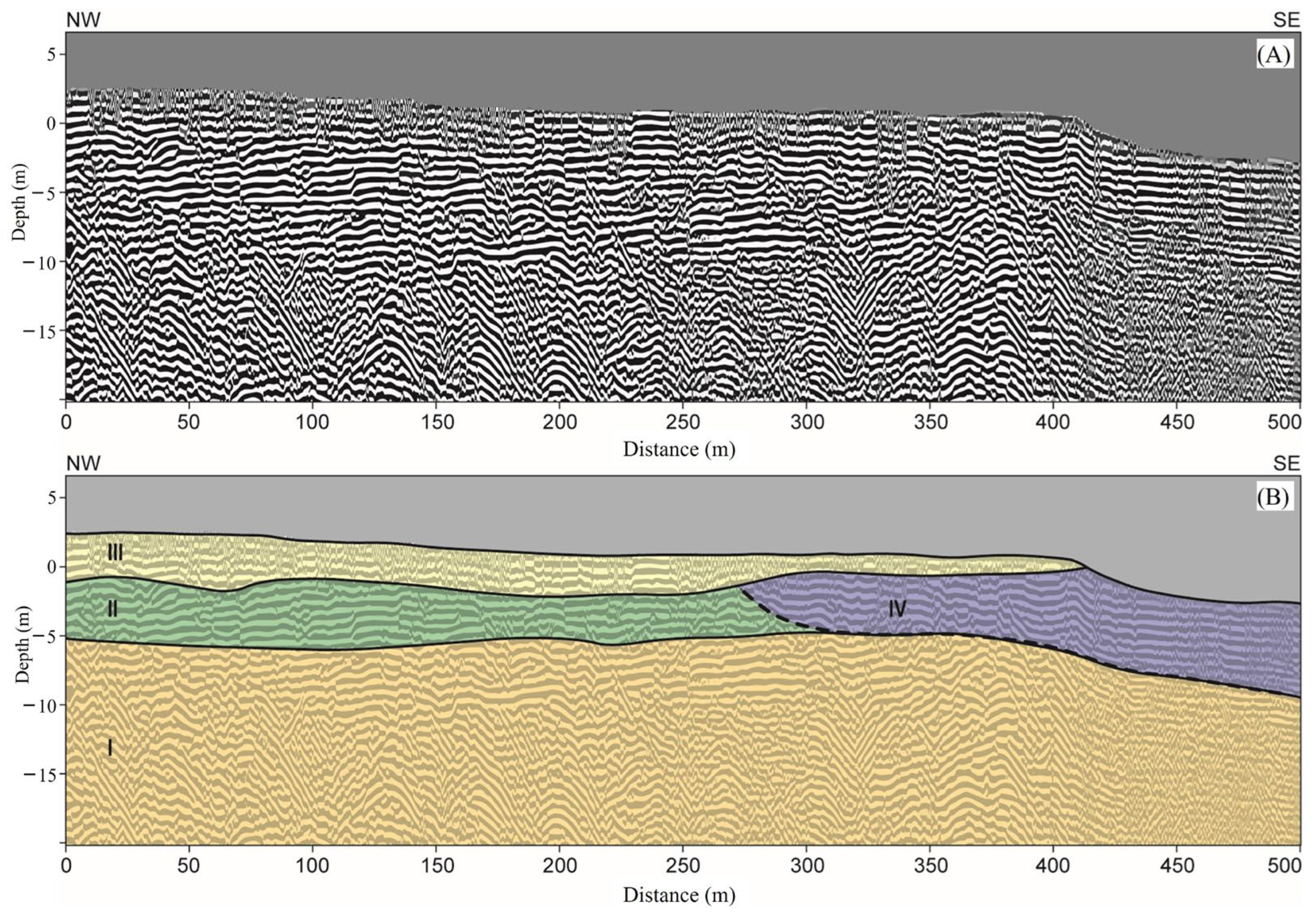

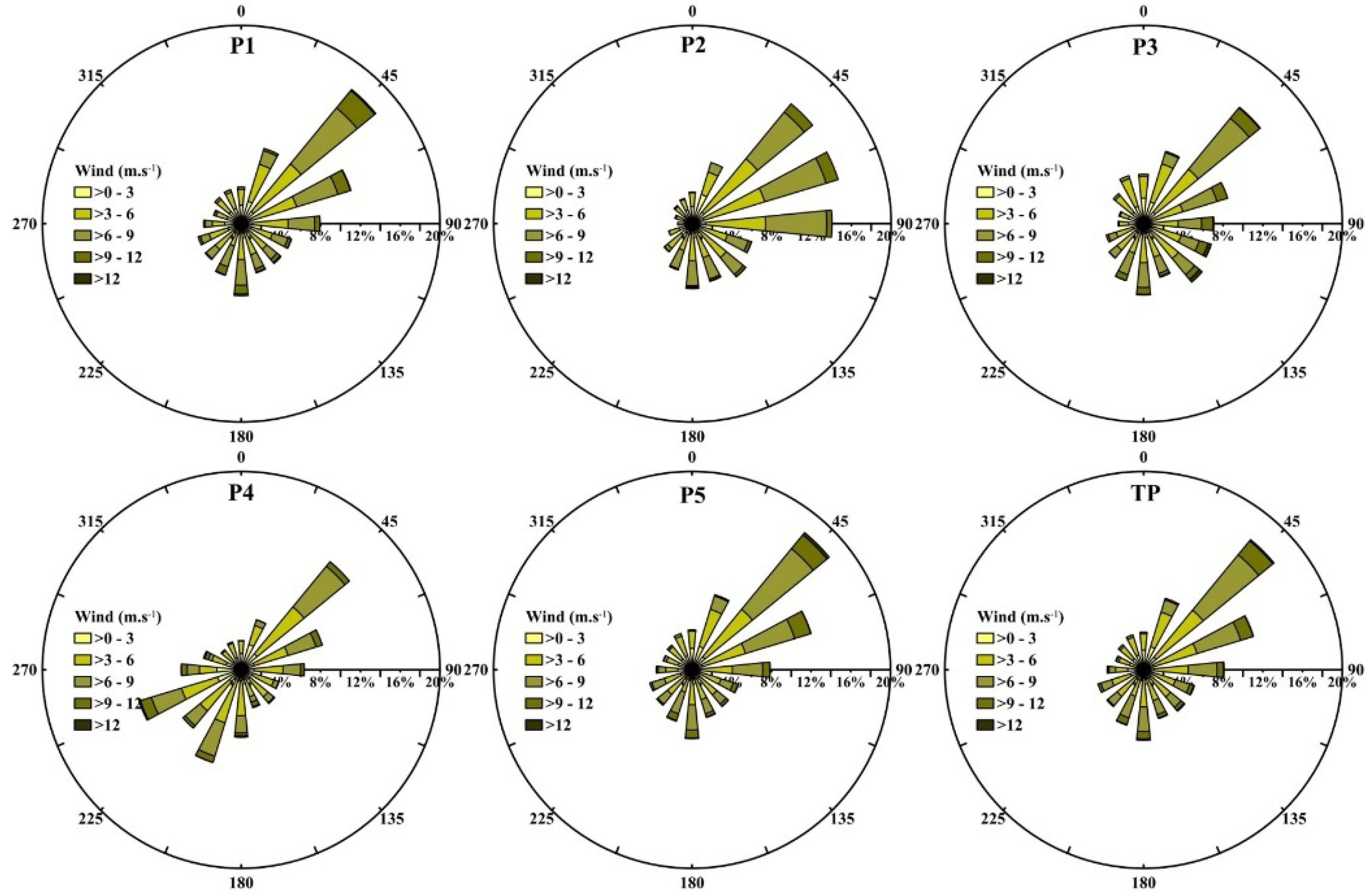
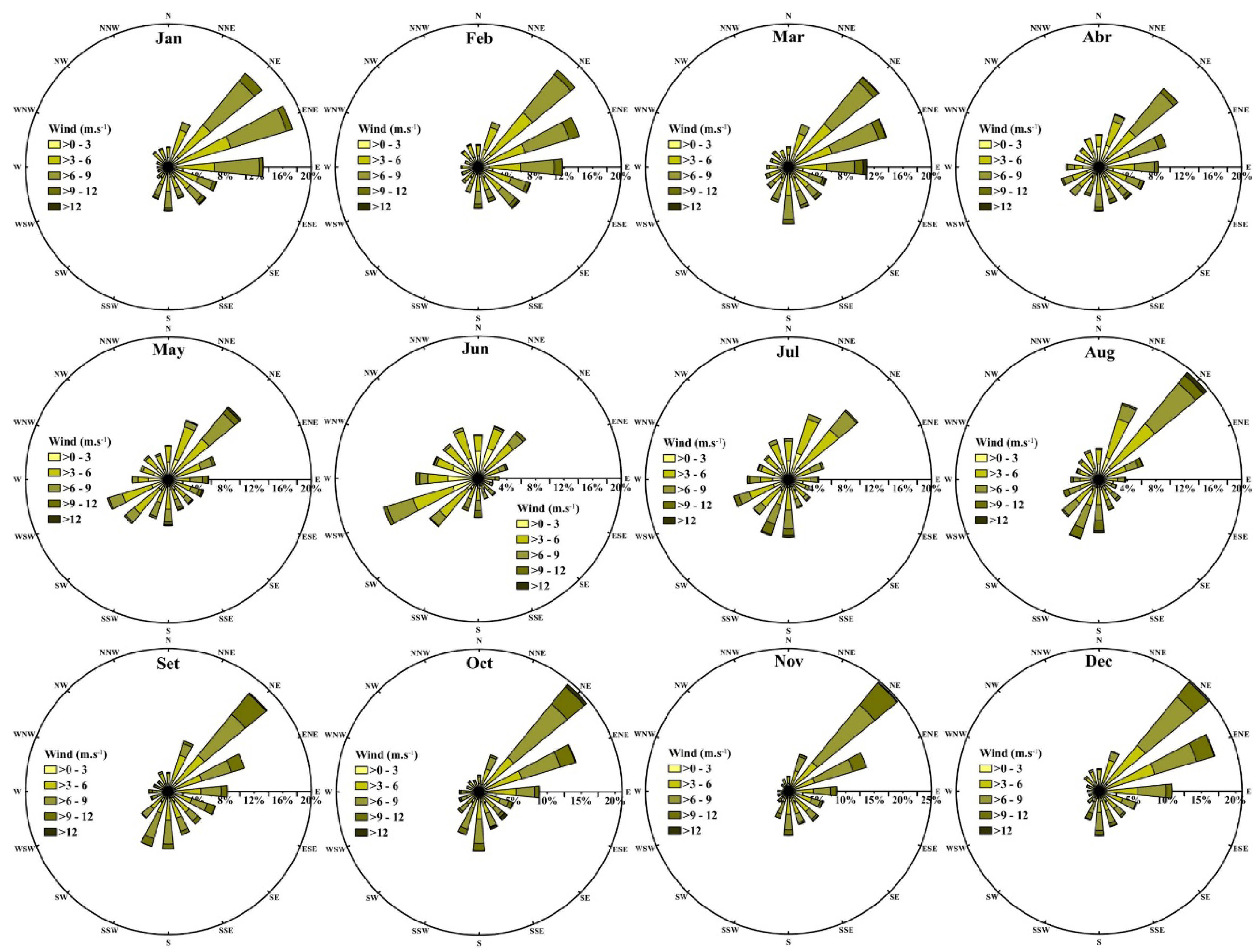
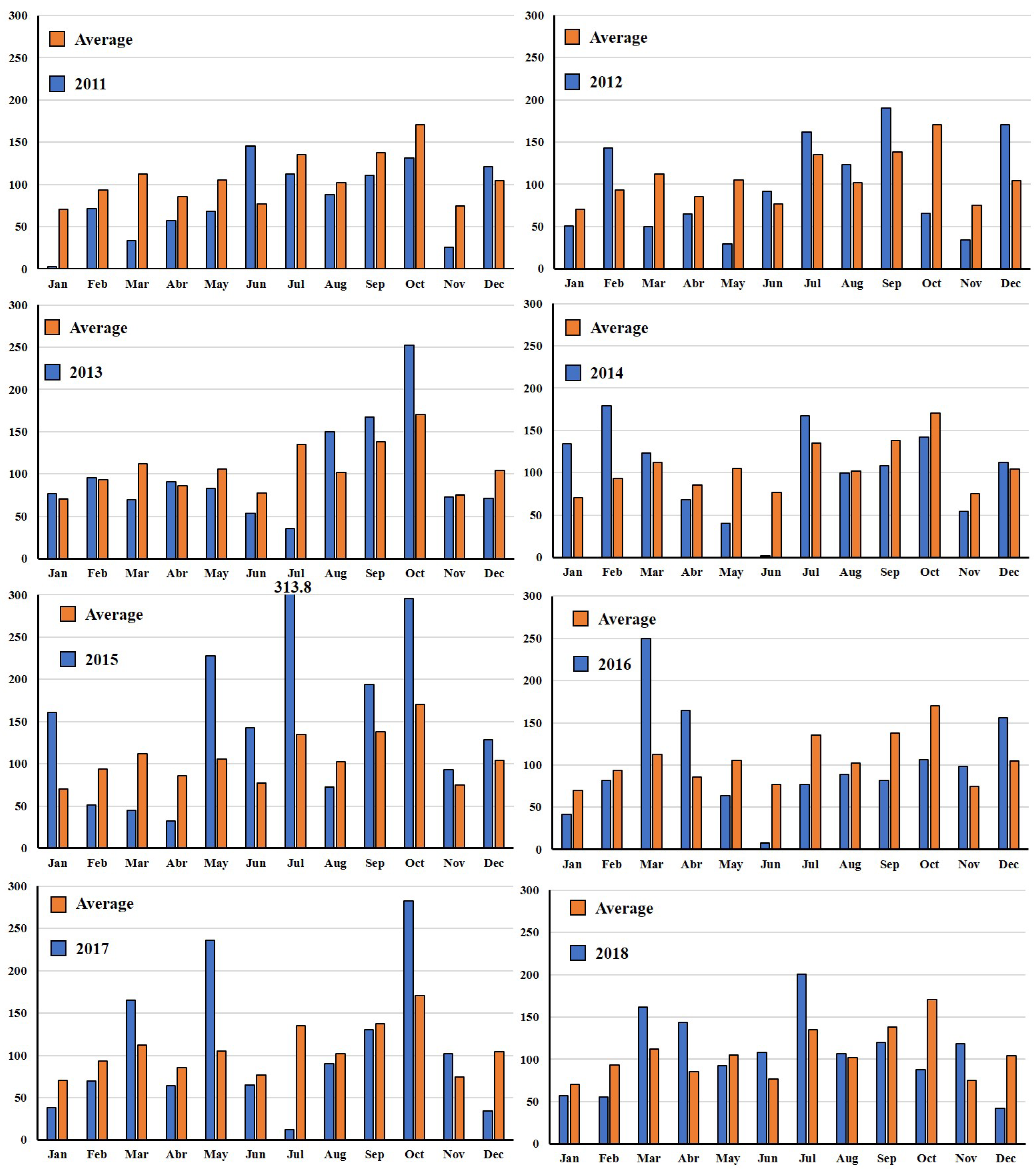
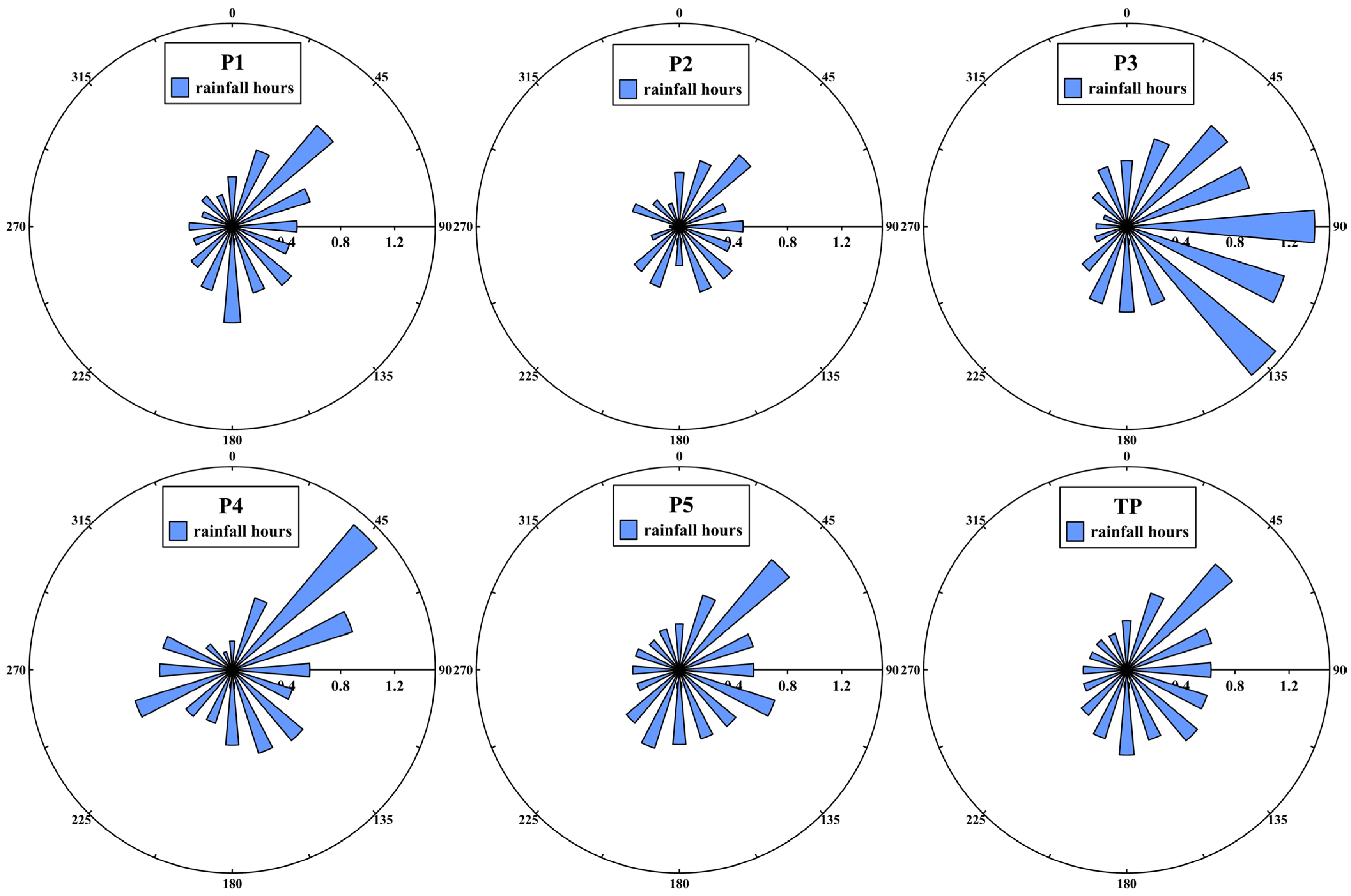
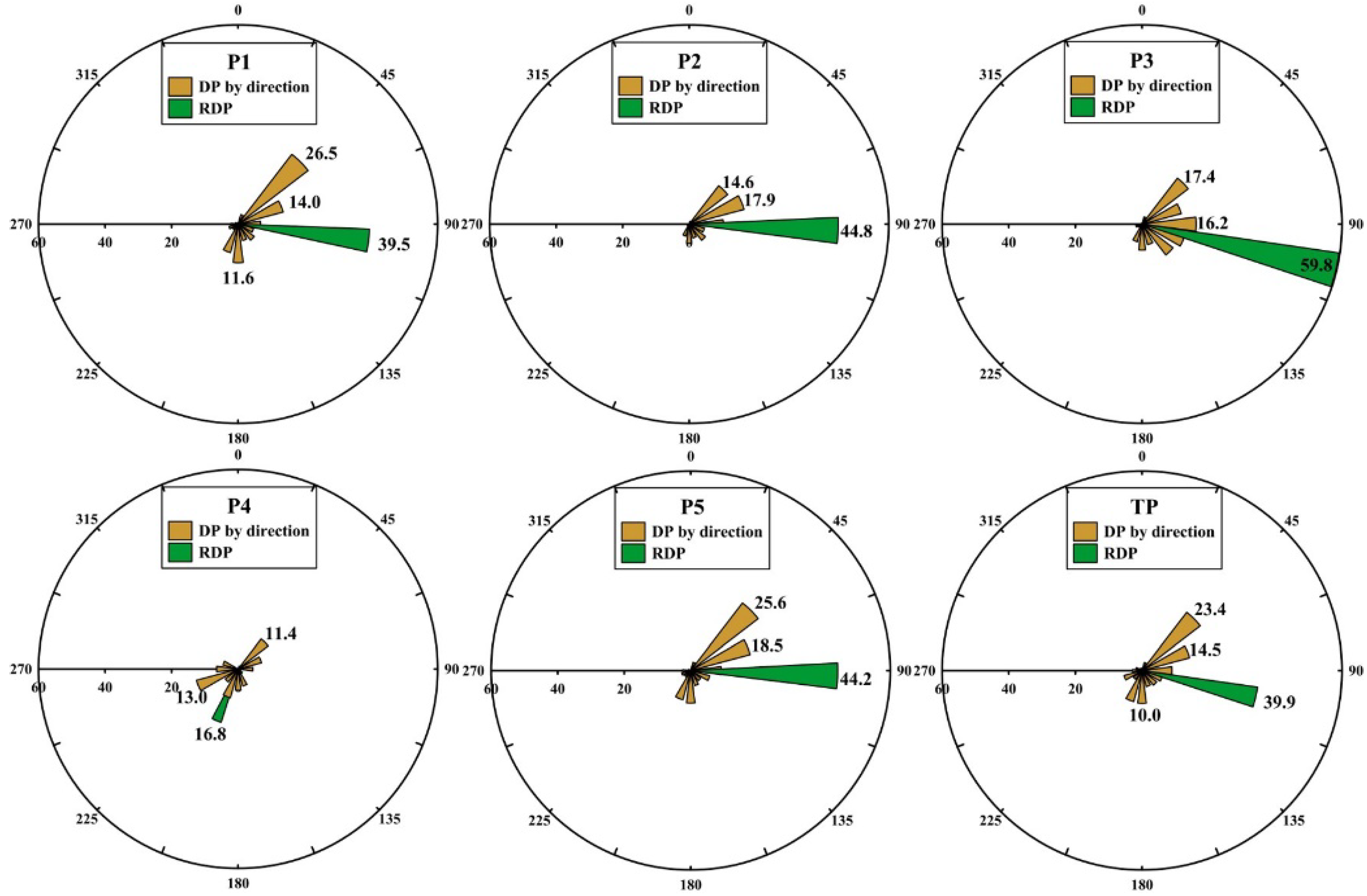

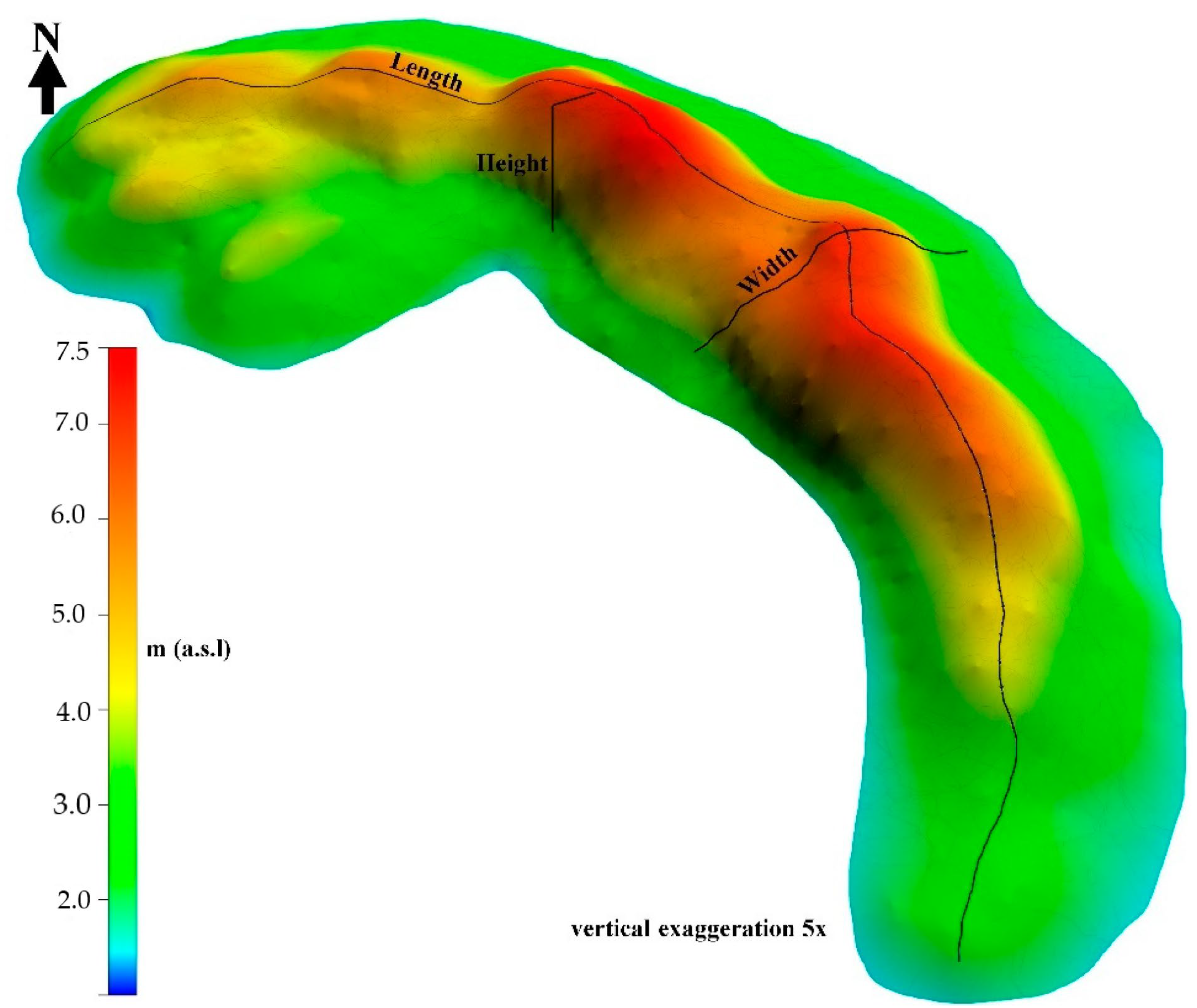
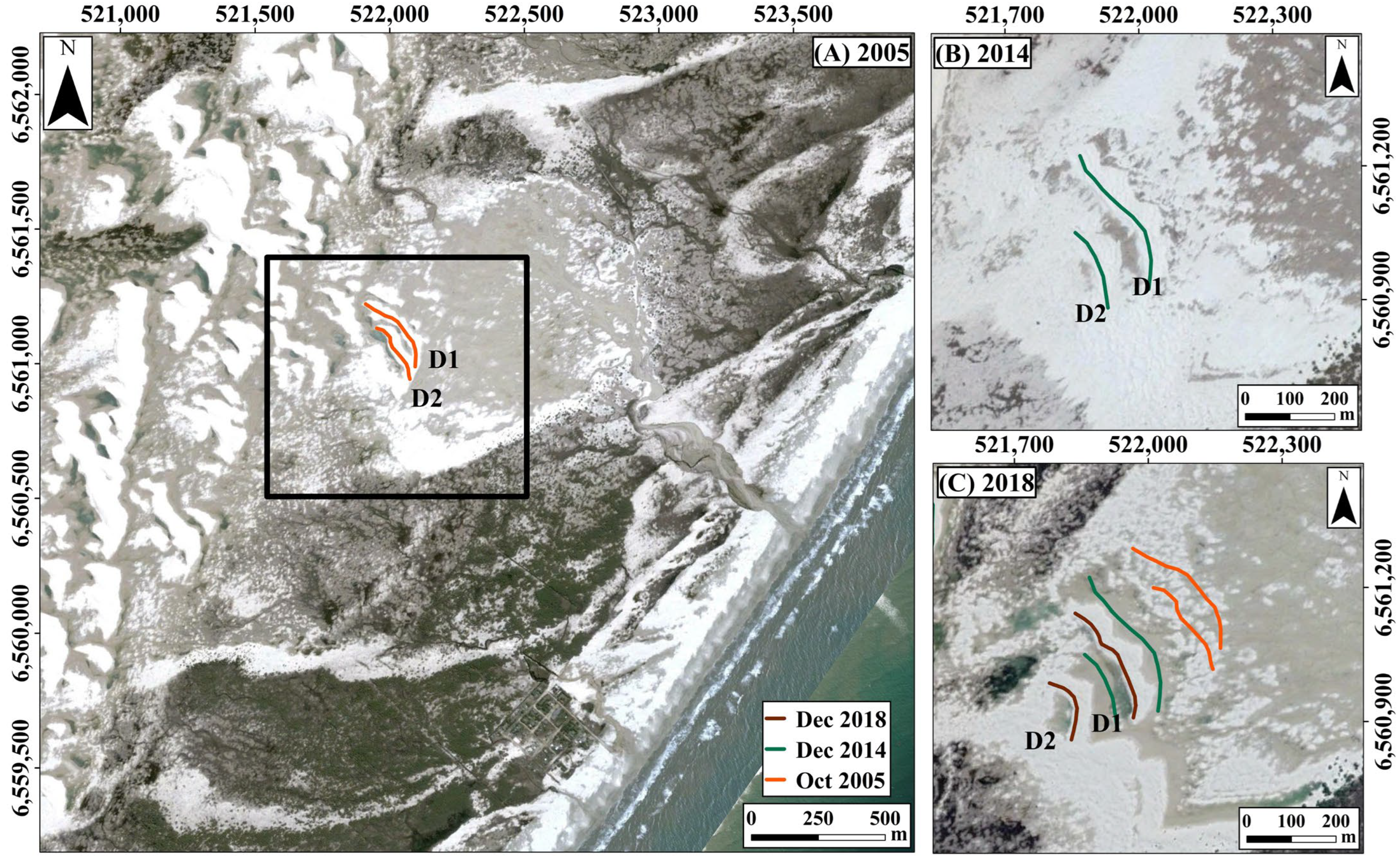
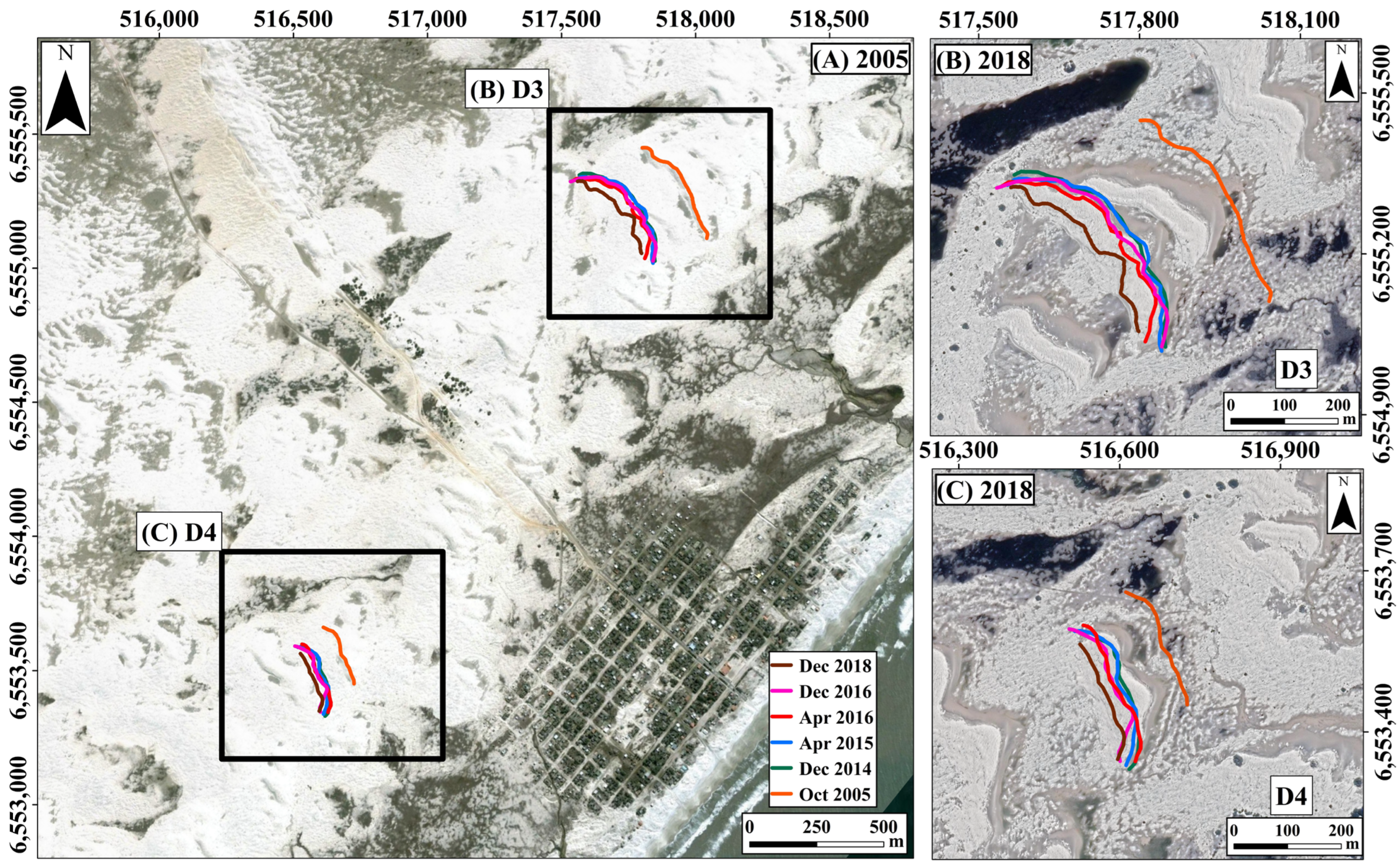

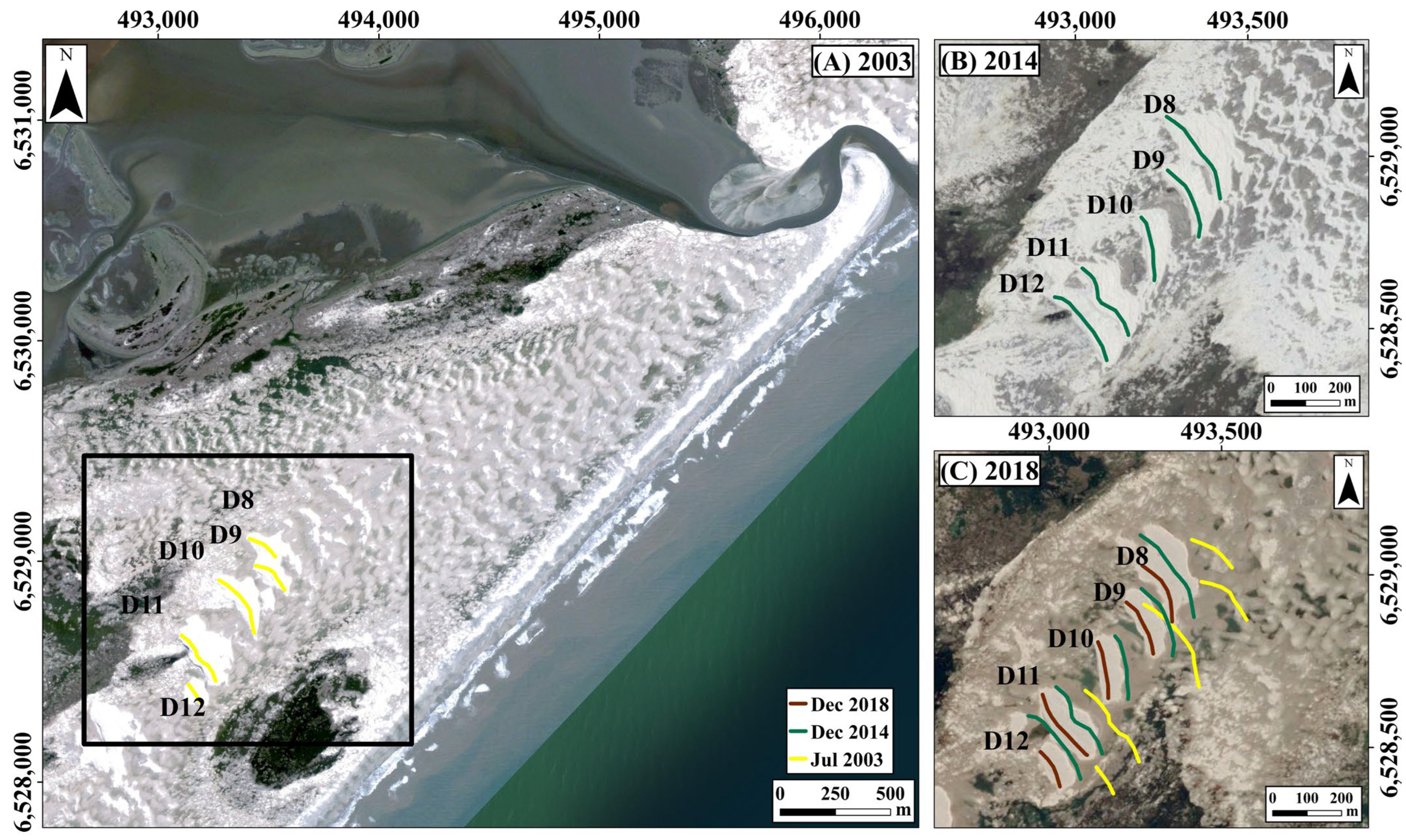
| Wind Frequency | ||||||||||||||||||
|---|---|---|---|---|---|---|---|---|---|---|---|---|---|---|---|---|---|---|
| N | NNE | NE | ENE | E | ESE | SE | SSE | S | SSW | SW | WSW | W | WNW | NW | NNW | Landward | Seaward | |
| P1 | 3.7 | 7.9 | 17.5 | 11.5 | 7.9 | 5.3 | 5.2 | 5.2 | 7.3 | 5.5 | 4.7 | 4.5 | 3.8 | 2.9 | 3.4 | 3.6 | 65.4 | 34.6 |
| P2 | 3.2 | 6.5 | 15.7 | 15.3 | 14.1 | 6.2 | 7.0 | 6.1 | 6.6 | 4.9 | 3.7 | 2.5 | 1.5 | 1.8 | 2.4 | 2.7 | 75.8 | 24.2 |
| P3 | 4.4 | 7.0 | 15.4 | 10.5 | 8.6 | 7.2 | 7.4 | 5.6 | 7.2 | 5.9 | 4.1 | 3.5 | 2.6 | 2.6 | 3.6 | 4.6 | 67.6 | 32.4 |
| P4 | 2.9 | 5.3 | 14.1 | 8.5 | 6.4 | 4.0 | 4.4 | 4.0 | 6.8 | 9.8 | 7.6 | 10.7 | 6.0 | 4.0 | 2.6 | 2.9 | 57.9 | 42.1 |
| P5 | 4.0 | 7.9 | 17.9 | 12.6 | 7.9 | 4.9 | 4.8 | 5.0 | 6.9 | 5.4 | 4.6 | 4.5 | 3.6 | 3.0 | 3.2 | 3.8 | 65.4 | 34.6 |
| TP | 3.8 | 7.5 | 17.0 | 11.6 | 8.1 | 5.4 | 5.4 | 5.1 | 7.1 | 5.8 | 4.8 | 4.8 | 3.7 | 2.9 | 3.3 | 3.7 | 65.5 | 34.5 |
| Sector 1 | Sector 2 | Sector 3 | Sector 4 | ||||||||||
|---|---|---|---|---|---|---|---|---|---|---|---|---|---|
| D1 | D2 | D3 | D4 | D5 | D6 | D7 | D8 | D9 | D10 | D11 | D12 | ||
| Dunes features | Type | IB | IB | BR | BR | BR | IB | IB | IB | IB | IB | IB | IB |
| Initial distance from the beach (m) | 1459 | 1453 | 1260 | 1237 | 810 | 771 | 675 | 901 | 774 | 741 | 727 | 721 | |
| Final distance from the beach (m) | 1555 | 1650 | 1439 | 1262 | 915 | 782 | 870 | 928 | 917 | 925 | 861 | 843 | |
| Initial width(m) | 44 | 51 | 116 | 75 | 89 | 30 | 83 | 82 | 92 | 117 | 171 | 95 | |
| Final width(m) | 60 | 54 | 72 | 85 | 68 | 69 | 53 | 130 | 75 | 71 | 113 | 66 | |
| Initial crest length(m) | 325 | 240 | 453 | 255 | 297 | 114 | 216 | 146 | 184 | 304 | 268 | 92 | |
| Final crest length(m) | 288 | 162 | 426 | 239 | 143 | 150 | 93 | 196 | 173 | 168 | 223 | 118 | |
| Maximum initial height (m) | --- | --- | 7.1 | 5.0 | 5.5 | 6.5 | 7.5 | --- | --- | --- | --- | --- | |
| Maximum final height (m) | --- | --- | 6.7 | 6.7 | 5.3 | 7.5 | 5.0 | --- | --- | --- | --- | --- | |
| Sector 1 | Sector 2 | Sector 3 | Sector 4 | |||||||||||||||||||||
|---|---|---|---|---|---|---|---|---|---|---|---|---|---|---|---|---|---|---|---|---|---|---|---|---|
| D1 | D2 | D3 | D4 | D5 | D6 | D7 | D8 | D9 | D10 | D11 | D12 | |||||||||||||
| Interval 1 | 1.67 | 231° | 2.18 | 259° | 1.87 | 263° | 1.1 | 241° | 1.31 | 232° | 1.21 | 269° | 1.4 | 270° | 1.44 | 274° | 1.88 | 275° | 1.44 | 276° | ||||
| Interval 2 | 1.38 | 236° | 1.67 | 267° | 1.22 | 284° | 0.67 | 301° | 1.00 | 260° | 1.63 | 276° | 1.59 | 262° | 0.75 | 280° | 0.73 | 283° | ||||||
| Sector 2 | Sector 3 | |||||||||
|---|---|---|---|---|---|---|---|---|---|---|
| D3 | D4 | D5 | D6 | D7 | ||||||
| P1 | 0.74 | 221° | 0.81 | 277° | ||||||
| P2 | 0.58 | 207° | 0.9 | 268° | 1.76 | 253° | 1.88 | 256° | 1.38 | 290° |
| P3 | 1.36 | 240° | 0.84 | 255° | 1.02 | 267° | 1.08 | 267° | 1.42 | 282° |
| P4 | 1.35 | 61° | 1.34 | 91° | 1.10 | 78° | 2.18 | 77° | 2.54 | 63° |
| P5 | 1.02 | 241° | 1.01 | 271° | 0.96 | 260° | 0.73 | 272° | 1.17 | 270° |
Disclaimer/Publisher’s Note: The statements, opinions and data contained in all publications are solely those of the individual author(s) and contributor(s) and not of MDPI and/or the editor(s). MDPI and/or the editor(s) disclaim responsibility for any injury to people or property resulting from any ideas, methods, instructions or products referred to in the content. |
© 2023 by the authors. Licensee MDPI, Basel, Switzerland. This article is an open access article distributed under the terms and conditions of the Creative Commons Attribution (CC BY) license (https://creativecommons.org/licenses/by/4.0/).
Share and Cite
Manzolli, R.P.; Portz, L.C.; Fontán-Bouzas, A.; Bitencourt, V.J.B.; Alcántara-Carrió, J. Contribution of Reverse Dune Migration to Stabilization of a Transgressive Coastal Dune Field at Lagoa do Peixe National Park Dune Field (South of Brazil). Remote Sens. 2023, 15, 3470. https://doi.org/10.3390/rs15143470
Manzolli RP, Portz LC, Fontán-Bouzas A, Bitencourt VJB, Alcántara-Carrió J. Contribution of Reverse Dune Migration to Stabilization of a Transgressive Coastal Dune Field at Lagoa do Peixe National Park Dune Field (South of Brazil). Remote Sensing. 2023; 15(14):3470. https://doi.org/10.3390/rs15143470
Chicago/Turabian StyleManzolli, Rogério Portantiolo, Luana Carla Portz, Angela Fontán-Bouzas, Volney Junior Borges Bitencourt, and Javier Alcántara-Carrió. 2023. "Contribution of Reverse Dune Migration to Stabilization of a Transgressive Coastal Dune Field at Lagoa do Peixe National Park Dune Field (South of Brazil)" Remote Sensing 15, no. 14: 3470. https://doi.org/10.3390/rs15143470
APA StyleManzolli, R. P., Portz, L. C., Fontán-Bouzas, A., Bitencourt, V. J. B., & Alcántara-Carrió, J. (2023). Contribution of Reverse Dune Migration to Stabilization of a Transgressive Coastal Dune Field at Lagoa do Peixe National Park Dune Field (South of Brazil). Remote Sensing, 15(14), 3470. https://doi.org/10.3390/rs15143470








